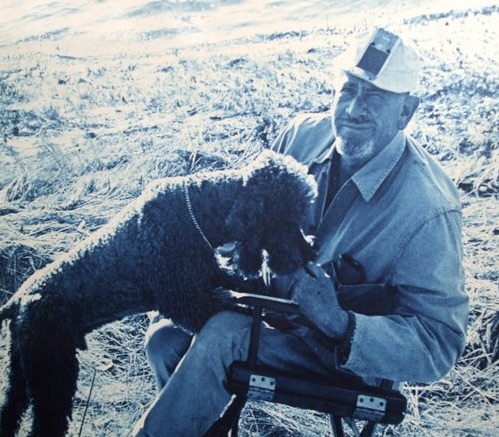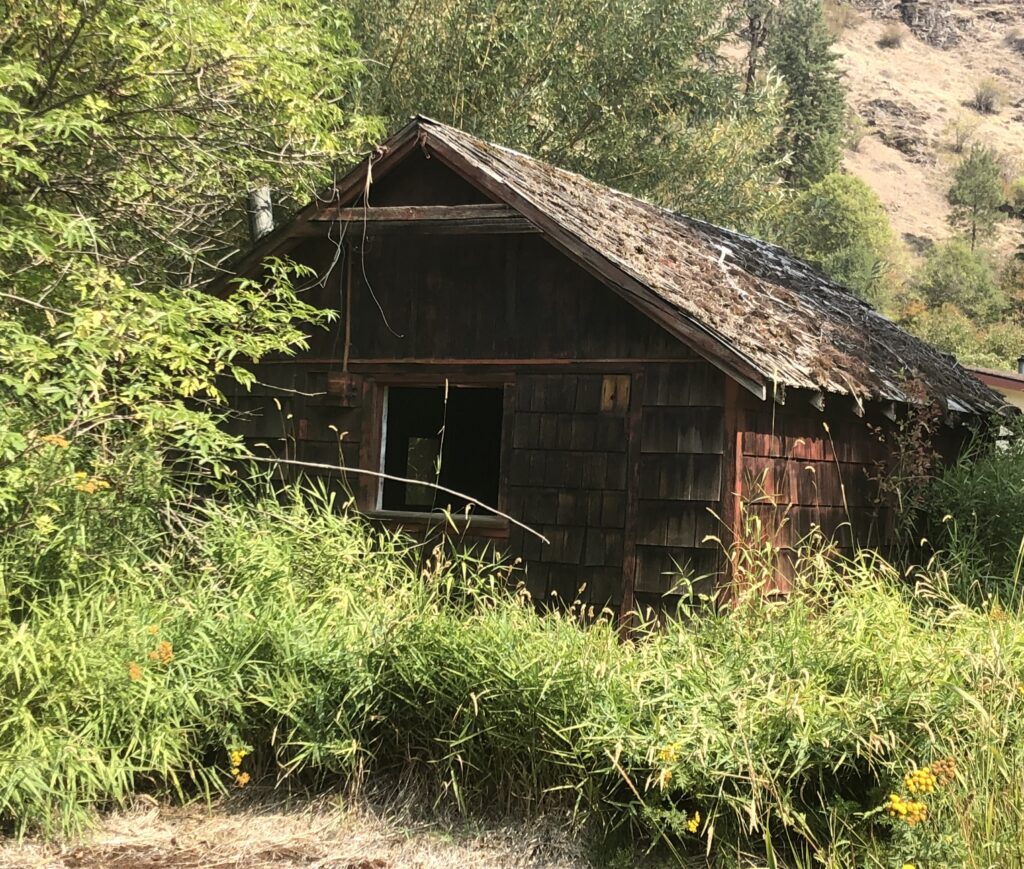The famous author stumbles into an uneasy father-son relationship during a quiet stopover near Coeur d’Alene.

Sometime in mid-October 1960, while trekking across the country, John Steinbeck stopped for the night just off U.S. 10 at “a little put-together, do-it-yourself group of cabins, square boxes, each with a stoop, a door, and one window, and no vestige of a garden or gravel paths.” He was, we reckon, just east of Coeur d’Alene, Idaho, near the site of today’s Wolf Lodge Campground.
When he tried to check in, the combination “store, repair shop, and lunch room behind the gas pumps” was empty, but Steinbeck heard the “sound of a quarrel … from the back room … a deep voice and a lighter male voice yammering back and forth.”
When Steinbeck asked, “Anybody home?” a burly man emerged to check him in and assign him a no-frills cabin — lumpy bed, “the aroma of mice and moisture, mold and the smell of old, old dust.” There was no bathtub, but the proprietor agreed to “bring you a bucket of hot water.” A single “naked globe,” i.e., a lightbulb, “hung from the ceiling.” “No effort had been spared to make the cabins uncomfortable and ugly,” Steinbeck wrote.
While the great novelist was getting settled,
“There was a knock on the door, and I admitted a young man of about twenty, dressed in gray flannel slacks, two-tone shoes, a polka-dotted ascot, and a blazer with the badge of a Spokane high school. His dark, shining hair was a masterpiece of over-combing, the top hair laid back and criss-crossed with long side strands that just cleared his ears.”
Steinbeck admitted, “He was a shock to me after the ogre of the lunch counter.”
Observing the New York license plates on Steinbeck’s pickup, the young man complained that there was no culture and nothing to do in this remote corner of Idaho, “no theater and no music, no one to — talk to.” He lived alone with his father — what happened to his mother is never explained. “I’m more like an orphan,” he explained. He aimed to get away — somewhere, maybe even New York.
Steinbeck joined father and son for a simple dinner in the back room of the store: “kitchen, larder, pantry, dining room — and the cot covered with army blankets made it bedroom too.” The gruff proprietor served “bubbling navy beans and fat-back.” He complained that Steinbeck’s New York license plates had stirred up his wayward son’s discontentment. “As if I ain’t carrying enough trouble, you got to be from New York.”

We learn now that the young man’s name is Robbie and that he has finished high school, but instead of settling into a typical rural life of hunting and fishing, he took a “night course” in “hairdressing. Not barbering.” “Hairdressing.” “For women.” “Now maybe you see why I got worries.”
This was 1960. Although the word “gay” first appeared in the Oxford English Dictionary in 1951, it had been circulating in the urban demimonde for a couple of decades. It did not achieve widespread use until the late 1970s. In 1960, a gay man would usually have been called “homosexual,” which could be pronounced in several ways depending on one’s politics. I can remember people like Alabama Governor George Wallace screwing up their mouths to say “homosexualist” in a mincing homophobic manner.
John Steinbeck knew plenty of gay men and women, of course, and he was an enlightened man. His treatment of the subject in Travels with Charley might seem clichéd or even contrived in our time, but it was gutsy for him to take on the subject in 1960, especially in an essentially upbeat book. Knowing more about how this family drama played out would be gratifying. Did Robbie give up his dreams? Did he abandon his lonely father to his bigotry and homophobia? Did he gravitate to Seattle, Spokane, or San Francisco? Did he marry a woman and go through the accepted social rituals in northern Idaho? Did he ever become a hairdresser? We don’t know. Not even the remarkably resourceful investigative reporter Bill Steigerwald was able to track down the rest of the story.
Of course, it is not certain that Robbie was a gay man, though that is the clear implication in Travels with Charley. Maybe he was just a young person who wanted more from life than the world his stern and righteous father represented and espoused. The shattering of the old primitive binary taxonomy — you are gay, or you are straight, with no in-between — in our time has liberated millions of young men and women to explore and chart their own gender roles and sexual destiny. We now live in a time of unprecedented sexual freedom. Thanks to the breathtaking cultural revolution of the last two decades, it is now possible for a young person to position themself anywhere on the gender spectrum they find fulfilling. Plenty of men who would have been labeled back then as homosexual or — as I heard it in my North Dakota youth — “a little light in the loafers” — were not necessarily gay. Still, since they didn’t conform to the rigid then-current template of male behavior, they were regarded with suspicion in the arena of “real men.”
I know and respect people — some of them my close friends — who think all this gender construction stuff has gone way too far, or at least too fast. Every time I think I am caught up with the social changes of our time, I see the redefining of culture moving faster than I can fully comprehend. I find myself wanting more deliberation time. And yet, I recognize “the fierce urgency of now.” I agree with former President Barack Obama, who said we will need to be more patient and forgiving of each other as we struggle to understand new ways of thinking about the important issues of life. Enlightenment is not easy, and what is touted as enlightenment is not always carefully balanced.
I know from observation that the old reductive gender paradigm for young rural men was deeply oppressive. Men don’t cry. Men don’t play with dolls. Men don’t write poetry. Men objectify women. Men have narrow and predictable aesthetic lives. Men kill things. Men drink beer. Men don’t use high falutin’ language. Men sneer at opera and ballet. Men love machines that have noisy internal combustion engines. Men watch football. Men know how to handle guns. Men admire John Wayne but not Andy Warhol.
At dinner, after confessing that he did not want to get caught in the middle of a family dispute, Steinbeck defended the young man’s career aspirations. He reports that he ate his beans and ham quickly, lest he be ordered off the premises. Then he said, “It is my considered opinion that the hairdresser is the most influential man in any community.”
Say, what?!
The angry father wanted to hear more about this. Steinbeck explained that women relax while having their hair done and reveal all sorts of things about themselves as if to a counselor or confessor. “When women place their secret lives in the hairdresser’s hands, he gains an authority few other men ever attain.” Etc. “I’m not smiling when I say it,” Steinbeck said. “I tell you that a clever, thoughtful, ambitious hairdresser wields a power beyond the comprehension of most men.”
The father’s position softened — a little improbably, in my opinion. Maybe there was more in this hairdresser thing than he had reckoned. He offered the incognito Steinbeck an after-dinner drink of whiskey. Steinbeck declined. Then, the host instructed his son to deliver a reading lamp to his guest’s cabin.
Robbie brought the table lamp. He was deeply gratified. “Mister, I don’t know if you believe all that you said, but you sure gave me a hand up.” Today the sentence might read, “I don’t know if you believe all that crap that came out of your mouth back there, but you helped my cause with the old man.”
Steinbeck had trouble sleeping that night. Like James T. Kirk, he knew he had broken the prime directive. “I had interfered,” he wrote, “in a matter that was none of my business.”
It’s a lovely, sad, even haunting story about a time in American life that is now mostly behind us. Steinbeck left early the following day for Seattle without re-engaging with his hosts. The kind of conflict that he stumbled in on — the gay young man and the outraged father — still occurs all over the United States.
And yet, think of how far we have come since 1960.
Remember when President Clinton said marriage was a covenant between a man and a woman? Remember when President Obama said he could not support same-sex marriage? Remember when American television explored gay lifestyles by way of The Odd Couple, Three’s Company, and Lennie and Squiggy?
Steinbeck handled the incident with great discretion and grace. You can, if you wish, read the incident and not conclude that the son is gay. Maybe he’s just more refined than those around him, more cultured, less locked into a certain narrow concept of gender construction. I grew up in that America.
What we have learned — are still painfully learning — is that the world is not as simple as black or white, male or female, gay or straight, aesthete or redneck, red or blue, conservative or liberal. Today, in most zip codes, that young man would have greater freedom and even some social encouragement to decide how he wanted to identify himself, privately and publicly.
How can you travel thousands of miles in an Airstream on the eve of our 250th birthday as a nation and not wish to understand the state of gender and sexual orientation in our time and compare it to what we know of life in the United States in 1960? My grandmother thought of Liberace as just a very flashy American entertainer — it would never have occurred to her to speculate about what he does in the dark. The distance we have traveled in the last 50 years would be difficult to exaggerate. And yet, there are pockets of great resistance that we must try to understand.
That’s why I’m out here using Travels with Charley as the framework to try to understand where we are as a people, how we got here, what has changed in the last 60 years, and where we seem to be headed.
Over the next few months, Clay is shadowing Steinbeck’s 10,000-mile trek around the USA (and making a few detours of his own). Clay’s expedition is a central part of LTA’s big initiative to explore the country and take the pulse of America as it approaches its 250th birthday. Be sure to follow Clay’s adventures here and on Facebook — and subscribe to our newsletter.
